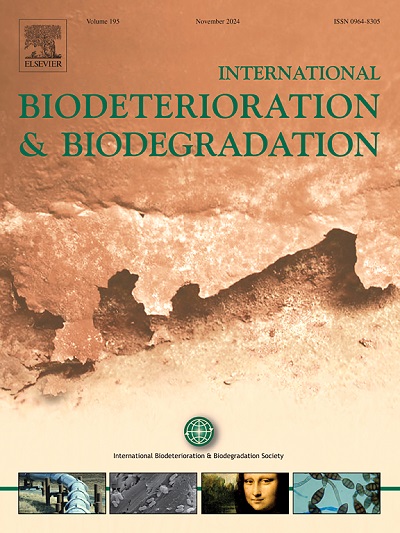Periphyton biofilms formulation and application for the removal of trace pollutants from water
IF 4.1
2区 环境科学与生态学
Q2 BIOTECHNOLOGY & APPLIED MICROBIOLOGY
International Biodeterioration & Biodegradation
Pub Date : 2025-02-01
DOI:10.1016/j.ibiod.2025.106003
引用次数: 0
Abstract
Freshwater resource contamination with trace metals (TMs) poses a major risk to public health and the ecosystem. In the current study, three distinct types of periphyton biofilms (PPBFs)—epiphyton, epilithon, and metaphyton—were cultured and employed to remove TMs from the simulated river water. The PPBFs were isolated from freshwater and then cultured in Bio-carrier of Organic Natural Aquatic Mate (BONAM). Based SEM analysis, the periphyton community appears porous and filamentous, with microscopic pores, unique individual cells, and extracellular matrix. Even while each PPBF has a unique structure and function, they all share rich active surface functional groups, particularly carboxylic groups. The epiphyton was found to be more effective for the removal of TMs when tested at 20 mg/L of the TMs as evidenced by the 79.50% elimination of arsenic (As) following 144 h of treatment. The removal performance of epiphyton decreased to just 57.40 and 51.60% at TMs concentration of 40 and 60 mg/L, respectively. Temperature had a significant impact on the biosorption of TMs utilising epiphyton, as evidenced by the removal efficiency of 75.05% at 15 °C, which decreased to 69.50 and 61.00% at 25 °C and 35 °C, respectively. The findings pertaining to the removal of TMs most accurately represented pseudo-first-order kinetics, indicating the bio-absorption of the TMs into the PPBFs. The elimination of almost 92% of TMs under optimal conditions of 90 h of incubation at neutral pH, 25 °C, 1.0 g L−1 of biomass, and 20 mg/L of TMs concentration demonstrated that epiphyton was the most effective biomaterial.
水生生物膜去除水中微量污染物的配方及应用
淡水资源受微量金属污染对公众健康和生态系统构成重大风险。在本研究中,我们培养了三种不同类型的附着生物膜(PPBFs)——附着生物膜(epiphyton)、附着生物膜(epilithon)和附着生物膜(metaphyon),并利用它们去除模拟河水中的TMs。从淡水中分离出ppbf,然后在有机天然水伴侣(BONAM)生物载体中培养。基于扫描电镜分析,周围植物群落呈现多孔和丝状,具有微观孔隙,独特的单个细胞和细胞外基质。尽管每个PPBF具有独特的结构和功能,但它们都具有丰富的活性表面官能团,特别是羧基。当浓度为20 mg/L时,附生菌对TMs的去除效果更明显,经过144小时的处理,砷(as)的去除率为79.50%。当TMs浓度为40和60 mg/L时,附生菌的去除率分别降至57.40%和51.60%。温度对附生菌对TMs的生物吸附有显著影响,15℃时的去除率为75.05%,25℃和35℃时分别降至69.50%和61.00%。有关TMs去除的研究结果最准确地代表了伪一级动力学,表明TMs进入ppbf的生物吸收。在中性pH、25°C、1.0 g L−1生物量和20 mg/L TMs浓度的最佳条件下,90 h TMs的去除率接近92%,表明附生菌是最有效的生物材料。
本文章由计算机程序翻译,如有差异,请以英文原文为准。
求助全文
约1分钟内获得全文
求助全文
来源期刊
CiteScore
9.60
自引率
10.40%
发文量
107
审稿时长
21 days
期刊介绍:
International Biodeterioration and Biodegradation publishes original research papers and reviews on the biological causes of deterioration or degradation.

 求助内容:
求助内容: 应助结果提醒方式:
应助结果提醒方式:


